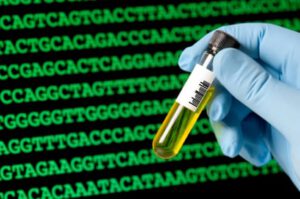
The term “sarcoma” encompasses over a hundred forms of rare cancers, and the cause behind many of these forms is unknown.
More on Ewing Sarcoma
Ewing sarcoma, however, is one sarcoma for which the biology is relatively well understood.
This form is caused by a gene fusion — a DNA rearrangement resulting in two genes being fused together. In the case of Ewing sarcoma, the fused genes are EWSR1 on chromosome 22 and typically FLI1 on chromosome 11. Although not much is known about risk factors for Ewing sarcoma, a recent study identified genetic variants associated with higher risk for the condition.
Now, a team of French researchers has uncovered the underlying cause of a new type of sarcoma: a different gene fusion.
New Research Findings
In this new study published in Nature Genetics, the team led by Olivier Delattre and Gaëlle Pierron studied tumors similar to Ewing sarcoma but lacking the EWSR1-FLI1 gene fusion, focusing primarily on bone sarcomas affecting adolescents and young adults. Altogether the researchers examined almost six hundred tumor samples and discovered that twenty-four of these tumors had identical genetic rearrangements — but a different one than that associated with Ewing sarcoma. This newly-discovered subtype of sarcoma results from a gene fusion between the BCOR and CCNB3 genes, both of which are located on the X chromosome.
The two genes involved in this new type of sarcoma both have important biological roles. The BCOR gene encodes a protein that regulates the activity of genes (specifically, genes within a type of stem cell found in bone marrow). Mutations in the BCOR gene can result in serious diseases, such as oculofaciocardiodental and Lenz microphthalmia syndromes. In addition, BCOR-CCNB3 is not the first documented gene fusion involving BCOR causing disease; when the BCOR gene fuses with the RARA gene on chromosome 17, the result is another cancer that affects the blood and bone marrow.
CCNB3
The role of the second gene, CCNB3, is somewhat less obvious. This gene encodes a protein expressed only in the testis and is important for the formation of new sperm cells.
The researchers hypothesized that the production of this protein in cells outside of the testis was a key factor in this new type of sarcoma. Using additional experiments, they observed that increased levels of CCNB3 protein led to increased cell proliferation — a hallmark of cancer — and that out of nearly one thousand tumor samples, only tumors with the BCOR-CCNB3 gene fusion had high levels of the protein encoded by the CCNB3 gene.
Delattre and Pierron’s findings suggest that the BCOR-CCNB3 gene fusion is directly related to the development of this form of sarcoma. This type of sarcoma may also share other attributes with the better-understood Ewing sarcoma, which results from a different gene fusion. Such new knowledge will hopefully translate into better sarcoma diagnoses and, someday, better treatments.



